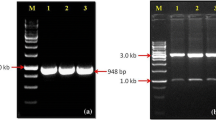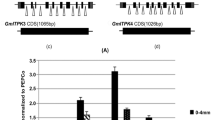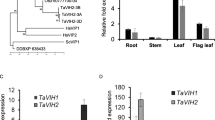Abstract
During seed development, phytic acid (PA) associated with mineral cations is stored as phytin and mobilized following germination in support of seedling growth. Two parallel biosynthetic pathways for PA have been proposed; yet the pathway is still poorly understood in terms of its regulation and the enzymes involved. Here, the castor bean (Ricinus communis L.) gene for inositol 1,3,4,5,6-pentakisphosphate 2-kinase (RcIPK1) has been identified. This encodes the enzyme implicated in catalyzing the final reaction in PA biosynthesis, and its expression is enhanced in isolated germinated embryos by application of phosphate and myo-inositol (Ins). Even though only one copy of the RcIPK1 gene is present in the genome, numerous RNA variants are present, most likely due to alternative splicing. These are translated into six closely related protein isoforms according to in silico analysis. Functional analyses using yeast ipk1Δ revealed that only three of the mRNA variants can rescue a temperature-sensitive growth phenotype of this strain. High-performance liquid chromatography (HPLC) analysis of the synthesized inositol phosphates demonstrated that the ability to complement the missing yeast IPK1 enzyme is associated with the production of enzyme activity. The three active isoforms possess unique conserved motifs important for IPK1 catalytic activity.






Similar content being viewed by others
Abbreviations
- PAIP 6 :
-
Phytic acid myo-inositol 1,2,3,4,5,6-hexakisphosphate
- RcIPK1 :
-
Ricinus communis inositol 1,3,4,5,6-pentakisphosphate 2-kinase
- Ins:
-
Myo-inositol
- Lpa:
-
Low phytic acid
- PtdIns:
-
Phosphatidylinositol
- HAI:
-
Hours after imbibition
- HPLC:
-
High-performance liquid chromatography
References
Azevedo C, Saiardi A (2006) Extraction and analysis of soluble inositol polyphosphates from yeast. Nat Protoc 1:2416–2422
Bartlett GR (1959) Phosphorus assay in column chromatography. J Biol Chem 234:446–448
Berridge MJ, Irvine RF (1989) Inositol phosphates and cell signaling. Nature 341:388–389
Biswas BB, Biswas S, Chakrabarti S, De BP (1978a) A novel metabolic cycle involving myo-inositol phosphates during formation and germination of seeds. In: Wells WW, Eisenberg JR (eds) Cyclitols and Phosphoinositides. Academic Press, New York, pp 57–68
Biswas S, Maity IB, Chakrabarti S, Biswas BB (1978b) Purification and characterization of myo-inositol hexaphosphate-adenosine diphosphate phosphotransferase from Phaseolus aureus. Arch Biochem Biophys 185:557–566
Bohn L, Meyer AS, Rasmussen SK (2008) Phytate: impact on environment and human nutrition. A challenge for molecular breeding. J Zhejiang Univ Sci B 9:165–191
Brearley CA, Hanke DE (1996) Metabolic evidence for the order of addition of individual phosphate esters to the myo-inositol moiety of inositol hexaphosphate in the duckweed Spirodela polyrhiza. Biochem J 314:227–233
Brearley CA, Hanke DE (2000) Metabolic relations of inositol 3,4,5,6-tetrakisphosphate revealed by cell permeabilization: identification of inositol 3,4,5,6-tetrakisphosphate 1-kinase and inositol 3,4,5,6 tetrakisphosphate phosphatase activities in mesophyll cells. Plant Physiol 122:1209–1216
Brown MJ, Greenwood JS (1990) Involvement of the Golgi apparatus in crystalloid protein deposition in Ricinus communis cv Hale seeds. Can J Bot 68:2353–2360
Chang S, Miller AL, Feng Y, Wente SR, Majerus PW (2002) The human homolog of the rat inositol phosphate multikinase is an inositol 1,3,4,6-tetrakisphosphate 5-kinase. J Biol Chem 277:43836–43843
Cosgrove DJ (1980) Inositol hexakisphosphates. In: Cosgrove DJ (ed) Inositol Phosphates. Their chemistry, biochemistry and physiology. Elsevier Scientific, The Netherlands, pp 26–43
Dorsch JA, Cook A, Young KA, Anderson JM, Bauman AT, Volkmann CJ, Murthy PPN, Raboy V (2003) Seed phosphorus and inositol phosphate phenotype of barley low phytic acid genotypes. Phytochemistry 62:691–706
Fiske CM, Subbarow Y (1925) The colorimetric determination of phosphorus. J Biol Chem 66:375–400
González B, Baños-Sanz JI, Villate M, Brearley CA, Sanz-Aparicioa J (2010) Inositol 1,3,4,5,6-pentakisphosphate 2-kinase is a distant IPK member with a singular inositide binding site for axial 2-OH recognition. Proc Nat Acad Sci USA 107:9608–9613
Greenwood JS, Bewley JD (1984) Subcellular distribution of phytin in the endosperm of developing castor bean: a possibility for its synthesis in the cytoplasm prior to deposition within protein bodies. Planta 160:113–120
Hurrell RF (2003) Influence of vegetable protein sources on trace element and mineral bioavailability. J Nutr 133:2973S–2977S
Irvine RF, Schell MJ (2001) Back in the water: the return of the inositol phosphates. Nature Rev Mol Cell Biol 2:327–338
Ito H, Fukuda Y, Murata K, Kimura A (1983) Transformation of intact yeast cells treated with alkali cations. J Bacteriol 153:163–168
Ives EB, Nichols J, Wente SR, York JD (2000) Biochemical and functional characterization of inositol 1,3,4,5,6- pentakisphosphate 2-kinases. J Biol Chem 275:36575–36583
Jongbloed AW, Lenis NP (1998) Environmental concerns about animal manure. J Anim Sci 76:2641–2648
Keim P, Olson TC, Shoemaker RC (1988) A rapid protocol for isolating soybean DNA. Soybean Genet Newsl 15:150–152
Kermode AR, Bewley JD (1989) Developing seeds of Ricinus communis L., when detached and maintained in an atmosphere of high relative humidity, switch to a germinative mode without the requirement for complete desiccation. Plant Physiol 90:702–707
Larkin MA, Blackshields G, Brown NP, Chenna R, McGettigan PA, McWilliam H, Valentin F, Wallace IM, Wilm A, Lopez R, Thompson JD, Gibson TJ, Higgins DG (2007) Clustal W and Clustal X version 2.0. Bioinformatics 23:2947–2948
Lott JNA (1984) Accumulation of seed reserves of phosphorus and other minerals. In: Murray DR (ed) Seed Physiology. Academic Press, New York, pp 139–166
Mendoza C (2002) Effect of genetically modified low phytic acid plants on mineral Absorption. Int J Food Sci Technol 37:759–767
Odom AR, Stahlberg A, Wente SR, York JD (2000) A role for nuclear inositol 1,4,5-trisphosphate kinase in transcriptional control. Science 287:2026–2029
Ogawa M, Tanaka K, Kasai Z (1979) Accumulation of phosphorus, magnesium, and potassium in developing rice grains: followed by electron microprobe X-ray analysis focusing on the aleurone layer. Plant Cell Physiol 20:19–27
Ongusaha PP, Hughes PJ, Davey J, Michell RH (1998) Inositol hexakisphosphate in Schizosaccharomyces pombe: synthesis from Ins(1,4,5)P3 and osmotic regulation. Biochem J 335:671–679
Onnebo SMN, Saiardi A (2009) Inositol pyrophosphates modulate hydrogen peroxide signalling. Biochem J 423:109–118
Organ MG, Greenwood JS, Bewley JD (1988) Phytin is synthesized in the cotyledons of germinated castor-bean seeds in response to exogenously supplied phosphate. Planta 174:513–517
Otegui MS, Capp R, Staehelin LA (2002) Developing seeds of Arabidopsis store different minerals in two types of vacuoles and in the endoplasmic reticulum. Plant Cell 14:1311–1327
Phillippy BQ, Ullah AHJ, Ehrlich KC (1994) Purification and some properties of inositol 1,3,4,5,6-pentakisphosphate 2-kinase from immature soybean seeds. J Biol Chem 269:28393–28399
Raboy V (1997) Accumulation and storage of phosphate and minerals. In: Larkins BA, Vasil IK (eds) Cellular and molecular biology of plant seed development. Kluwer Academic Publishers, Dordrecht, pp 441–477
Raboy V (2001) Seeds for a better future: “low phytate” grains help to overcome malnutrition and reduce pollution. Trends Plant Sci 6:458–462
Raboy V (2003) myo-Inositol-1,2,3,4,5,6-hexakisphosphate. Phytochemistry 64:1033–1043
Raboy V, Bowen D (2006) Genetics of inositol polyphosphates. In: Majumder AL, Biswas BB (eds) Biology of Inositols and phosphoinositides. Springer, The Netherlands, pp 71–102
Raboy V, Young KA, Dorsch JA, Cook A (2001) Genetics and breeding of seed phosphorus and phytic acid. J Plant Physiol 158:489–497
Reddy ASN (2007) Alternative splicing of pre-messenger RNAs in plants in the genomic era. Annu Rev Plant Biol 58:267–294
Saiardi A, Caffrey JJ, Snyder SH, Shears SB (2000) The inositol hexakisphosphate kinase family: catalytic flexibility and function in yeast vacuole biogenesis. J Biol Chem 275:24686–24692
Saiardi A, Sciambi C, McCaffery JM, Wendland B, Snyder SH (2002) Inositol polyphosphates regulate endocytic trafficking. Proc Nat Acad Sci USA 99:14206–14211
Sambrook J, Russell DW (2001) Molecular cloning a laboratory manual, 3rd ed. Cold Spring Harbor Laboratory Press: Cold Spring Harbor, New York
Sharpley AN, Chapra SC, Wedepohl R, Sims JT, Daniel TC, Reddy KR (1994) Managing agricultural phosphorus for protection of surface waters: issues and options. J Environ Qual 23:437–451
Shears SB (2004) How versatile are inositol phosphate kinases? Biochem J 377:265–280
Stephens LR, Irvine RF (1990) Stepwise phosphorylation of myo-inositol leading to myo-inositol hexakisphosphate in Dictyostelium. Nature 346:580–583
Stevenson-Paulik J, Phillippy BQ (2010) Inositol Polyphosphates and Kinases. In: Munnik T (ed) Lipid signaling in plants, plant cell monographs 16. Springer, Berlin, pp 161–174
Stevenson-Paulik J, Odom AR, York JD (2002) Molecular and biochemical characterization of two plant inositol polyphosphate 6-/3-/5-kinases. J Biol Chem 277:42711–42718
Stevenson-Paulik J, Bastidas RJ, Chiou S, Frye RA, York JD (2005) Generation of phytate-free seeds in Arabidopsis through disruption of inositol polyphosphate kinases. Proc Nat Acad Sci USA 102:12612–12617
Strother S (1980) Homeostasis in germinating seeds. Ann Bot 45:217–218
Sun Y, Thompson M, Lin G, Butler H, Gao Z, Thornburgh S, Yau K, Smith DA, Shukla VK (2007) Inositol 1,3,4,5,6-pentakisphosphate 2-kinase from maize: molecular and biochemical characterization. Plant Physiol 144:1278–1291
Suzuki M, Tanaka K, Kuwano M, Yoshida KT (2007) Expression pattern of inositol phosphate-related enzymes in rice (Oryza sativa L.): implications for the phytic acid biosynthetic pathway. Gene 405:55–64
Sweetman D, Johnson S, Caddick SEK, Hanke DE, Brearley CA (2006) Characterization of an Arabidopsis inositol 1,3,4,5,6-pentakisphosphate 2-kinase (AtIPK1). Biochem J 394:95–103
Verbsky JW, Wilson MP, Kisseleva MV, Majerus PW, Wente SR (2002) The synthesis of inositol hexakisphosphate. J Biol Chem 277:31857–31862
Verbsky JW, Chang S, Wilson MP, Mochizuki Y, Majerus PW (2005) The pathway for the production of inositol hexakisphosphate in human cells. J Biol Chem 280:1911–1920
Wang BB, Brendel V (2006) Genome-wide comparative analysis of alternative splicing in plants. Proc Nat Acad Sci USA 103:7175–7180
Weaver CM, Kannan S (2002) Phytate and mineral bioavailability. In: Sathe SK (ed) Reddy NR. CRC Press, Food phytates Florida, pp 211–223
York JD, Odom AR, Murphy R, Ives EB, Wente SR (1999) A phospholipase C-dependent inositol polyphosphate kinase pathway required for efficient messenger RNA export. Science 285:96–100
Yoshida KT, Wada T, Koyama H, Mizobuchi-Fukuoka R, Naito S (1999) Temporal and spatial patterns of accumulation of the transcript of myo-inositol-1-phosphate synthase and phytin-containing particles during seed development in rice. Plant Physiol 119:65–72
Yuan F-J, Zhu D-H, Tan Y–Y, Dong D-K, Fu X-J, Zhu S-L, Li B-Q, Shu Q-Y (2012) Identification and characterization of the soybean IPK1 ortholog of a low phytic acid mutant reveals an exon-excluding splice-site mutation. Theor Appl Genet 125:1413–1423
Acknowledgments
This research was supported by Natural Sciences and Engineering Research Council of Canada Discovery grants (106265) to JSG and (044191) JDB.
Author information
Authors and Affiliations
Corresponding author
Electronic supplementary material
Below is the link to the electronic supplementary material.
Rights and permissions
About this article
Cite this article
Yu, J., Saiardi, A., Greenwood, J.S. et al. Molecular and biochemical identification of inositol 1,3,4,5,6-pentakisphosphate 2-kinase encoding mRNA variants in castor bean (Ricinus communis L.) seeds. Planta 239, 965–977 (2014). https://doi.org/10.1007/s00425-014-2028-z
Received:
Accepted:
Published:
Issue Date:
DOI: https://doi.org/10.1007/s00425-014-2028-z




